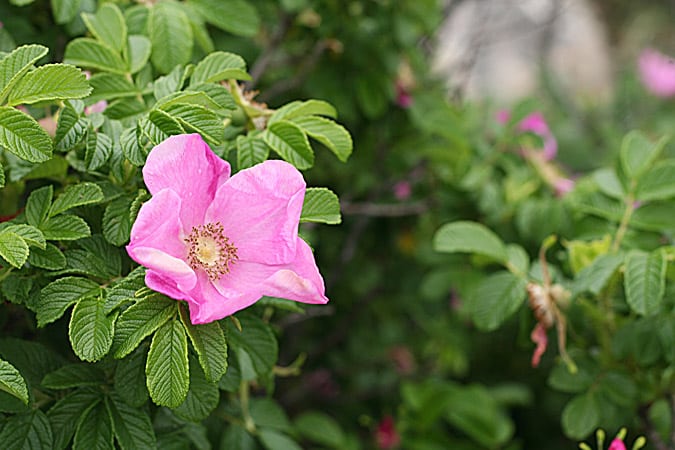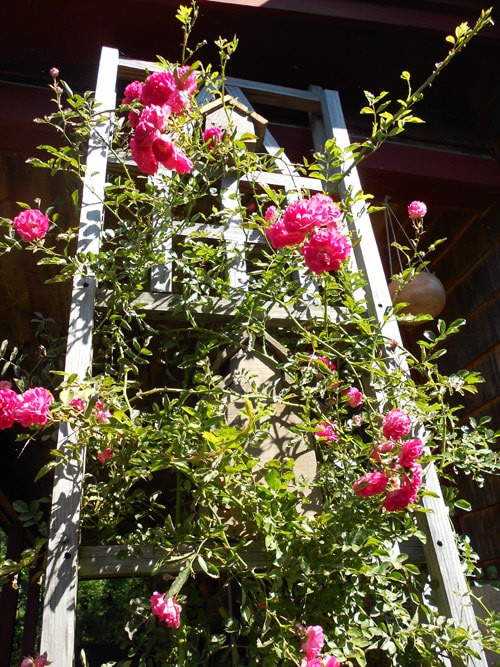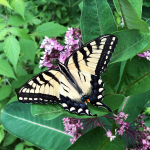Gardens
Easiest Roses to Grow in New England
Learn about the easiest types of roses to grow in New England, all of which are hardy enough to survive — and even thrive — in our harsh climate.

Coffee By Design | Portland, Maine
Photo Credit : Katherine KeenanEasiest Roses to Grow in New England
Beach Roses (Rosa rugosa)
Beach roses are fast-growing bushes that spread quickly and are covered with continually blooming pink or white flowers. They thrive in almost all soil types — from sandy beaches to roadside fences. Once planted, beach roses require very little attention, making them one of the easiest types of roses to grow anywhere.Climbing Roses
A trellis hanging heavy with fragrant roses is a breathtaking and romantic sight, and one that has been seen in New England gardens for centuries. There are dozens of climbing roses to choose from. Consult your local nursery for available options.Tea Roses
Originally hybrids from China, these roses have evolved and have been successfully cultivated in northeastern gardens for many years, though they may require wood-framed protection in the winter. They are larger than most climbing roses and are very fragrant. Traditionally found in shades of pink and yellow, they are also available in white and red.Guide to Planting Roses
Supplies for Planting Roses
- Shovel
- Bucket
- Hose or watering can
- Spade
- Rose bush
- Bone meal
- Aged cow manure
- Peat
- Potting soil
- Mulch
Soil Recipe
Mix together equal amounts (approximately 1/2 cup of each for a medium to large size bush — less for smaller plants) of peat, composted cow manure, bone meal, and potting soil.
Photo Credit : Shelley Wigglesworth
Instructions for Planting Roses
- Prepare ahead of time a mixture of equal parts peat, composted cow manure, bone meal, and potting soil. (See above recipe.)
- Choose a sunny location and dig a hole that is double the width and depth of the root ball.
- Gently remove the rose plant from the container and loosen the root ball.
- Place the rose plant in the hole so that the entire root ball is evenly standing underground. The top of the root ball should be flush to the top of the ground.
- Sprinkle the mixture of bone meal, soil, manure, and peat into the hole around the shrub and fill the remaining space with clean, rich soil. Cover the top of the root ball with approximately 2 inches of soil, being careful to ensure that the stem or stalk of the plant is not covered with dirt.
- Spread a few inches of mulch around the plant and water thoroughly every few days.
- To increase and encourage new rose bud growth, snip off weak, faded, and past-peak blooms as they appear.
- In the fall, be sure to mulch deeply. Alternatively, wrap fragile shrubs in burlap or cover with a wooden pitched box to protect them from heavy snow and ice — unless, of course, they are beach roses; these bushes are hardy and can survive just about anything.








My daughter took some climbing roses from her grandma’s yard on Cape Cod and planted them
along her wall in Plano, Texas. They are especially beautiful falling into her pool area in full bloom this June of 2013.
Thanks for sharing Martha-if you are able to post a photo next season that would be great!
There are so many roses that are easy to grow in New England and planting correctly is so important as you suggest. One tip I would like to add is when planting a grafted rose in New England, make sure the bud union is below soil level. How far below depends on the hardiness zone you are in. Here in Rhode Island we plant the bud union 2 inches below soil level. In colder areas plant deeper.
Will beach roses survive in an area that flood tide comes up?
Beach roses are very tolerant. Where I live in Maine, beach roses that grow right where the sand line stops are exposed to flood tides from the ocean periodically and it does not seem to do any harm. Constant exposure may have adverse effects, but periodic, flood tides do not seem to harm the beach roses. Great question! Thank you!
What time of year should I plant rose bush in Maine?
Hi, I have a wild rose bush in my yard that initially has beautiful pink blooms. However, after that first bloom, the rose buds start turning black and drying. How can I stop this? Thanks.
You cant. It will happen, pinching off can prolong it but not stop it.
My daughter had a rose bush sent to me and it now has a lot of yellow leaves. I haven’t planted it yet due to the weather being cold at night. What can I do to get the Rose plant to stop turning the leaves yellow? I don’t want the Rose Bush to die! Help!
Yellowed leaves can be a result of several issues, ranging from simple over/under watering, soil nutrient deficiency, or fungal diseases. All are fairly easy to control but may require use of commonly found chemicals. Try contacting your local rose society for information- some societies will even send a volunteer to your house to help you figure out what’s going on. You should know that most modern roses (hybrid teas, which is the bulk of what is sold at regular nurseries) require anti-fungal spraying to stay fungus-free. Good luck!
In Connecticut, Rosa rugosa (the beach rose) is listed as an invasive species unfortunately, and is not recommended to be planted in-ground because of its ability to spread and form colonies fairly quickly. Well intended people have no idea. Rosa carolina, Rosa virginiana, and Rosa palustris are alternatives for coastal rose species that are easy to grow and look like Rosa rugosa without being invasive. Happy planting everyone! It is easy to find information online about the invasive species for your particular state.
Living in a tidal zone in Virginia Beach we were flooded in the yard four to five times a year. This Rose always survived and put off the greatest fragrance!
If anybody out there knows how about that southern Outer Banks of North Carolina, I am looking to plant this rose again
One of the heartiest, easiest, wildly fragrant roses that I grow is “Zepherine Drouhin”, a beautiful climbing rose. It blooms madly in June and the air is so fragrant that one is drawn to it as if by a magnet. And, happily, on towards Autumn, it has a second flush, albeit a much smaller one. Easy, worthwhile rose.
We live in a Rhode Island and have had a pretty consistent experience that when we have used bone meal it attracts critters!!
The article mentions planting Tea roses. Please let your readers know that they must have meant Hybrid Tea roses. True Tea roses are the ancestors of modern Hybrid Teas. Unlike their offspring, they are actually very tender and cannot be grown in climates with cold winters. People do confuse the two, but there is an important difference in where they can be grown.